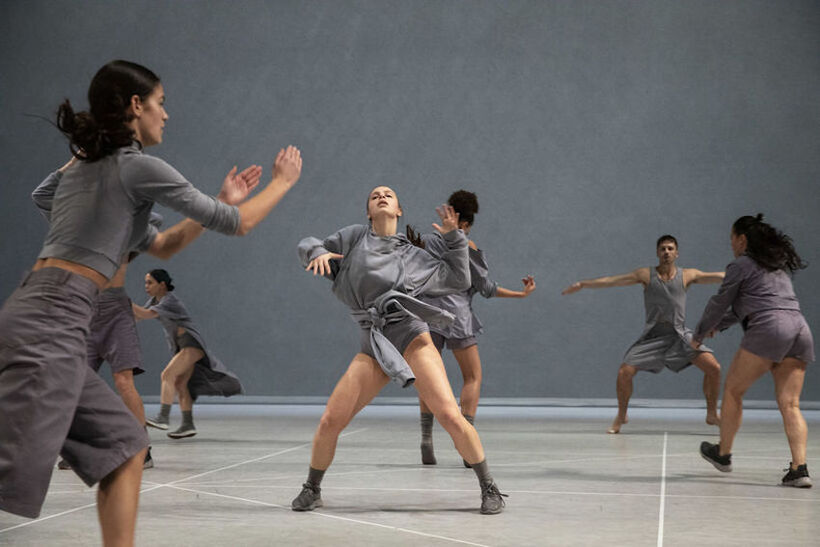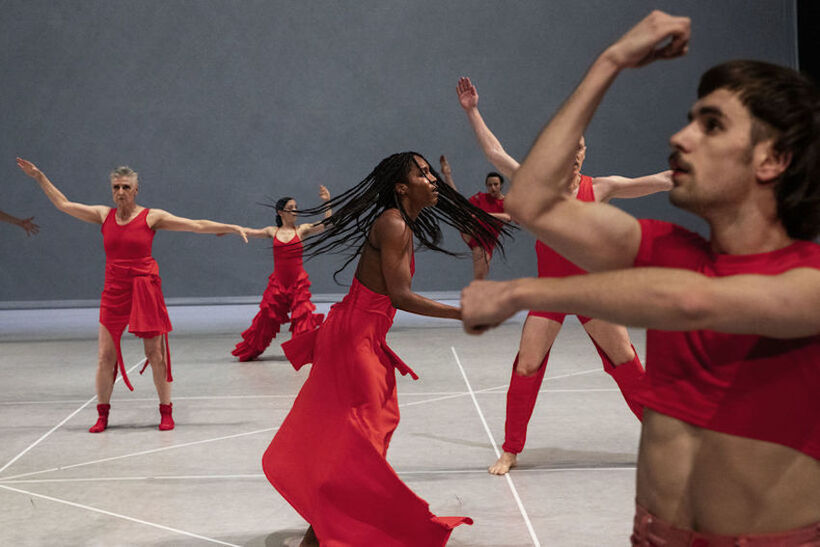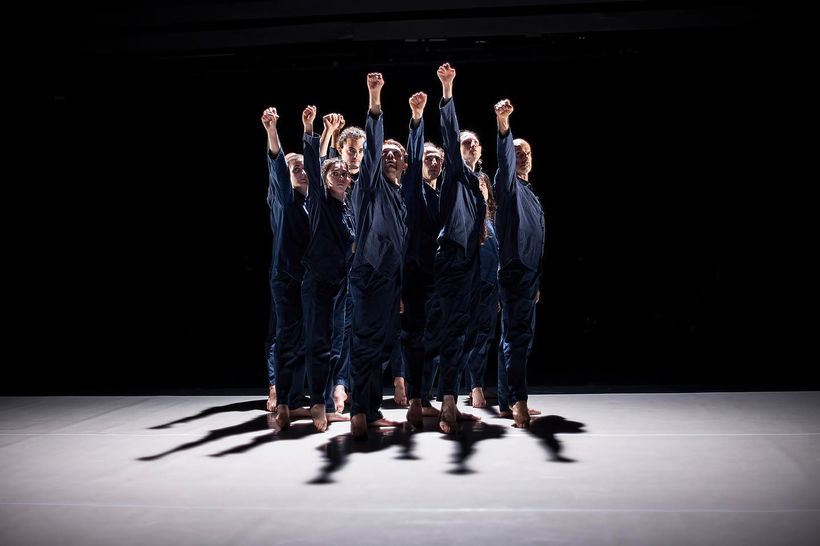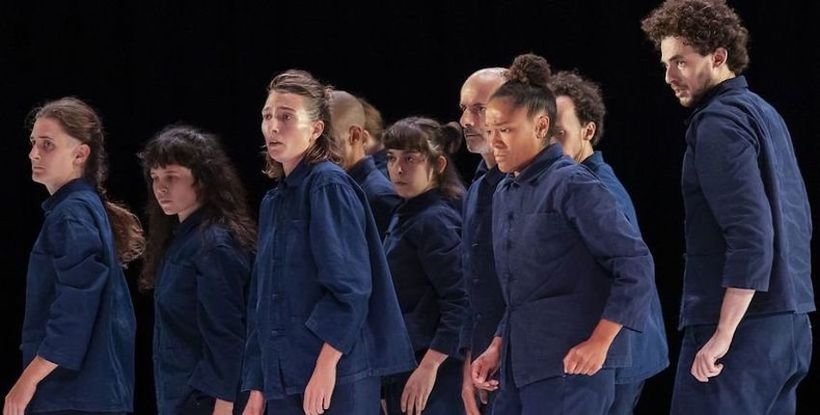Jan Martens and Oona Doherty at TANEC PRAHA - About Humanity, Doom and Hope
In its third week, the TANEC PRAHA festival presented two personalities of contemporary European choreography: the Belgian Jan Martens and the Irish Oona Doherty. They are creators of the younger middle generation, who have had considerable success on the European stage and, most importantly, who have something to say. Their significance has been directly proportional to the size of the productions, or rather the number of dancers performing in them, which was relatively high not only in our country, but also by the standards of European independent work. Martens' any attempt will end in crushed bodies and shattered bones featured seventeen performers (ranging in age from 18 to 71), while Oona Doherty's Navy Blue featured eleven dancers.
While we are accustomed to large numbers of dancing bodies on the stages of subsidised theatre companies, this is a rather rare occurrence on the independent scene for operational and financial reasons. Yet the larger company offers great potential in terms of composition and expression, and it is very interesting to observe the individuality of the contemporary dancers in the context of the group. It was these aspects (but not only) that captured my attention in both performances, presented in one week on two larger Prague stages (larger in terms of the independent scene): the Hybernia and the Archa theatres. The works were very different in their composition, principles and content, but their juxtaposition brings productive insights into the possibilities and meaning of working with a group in contemporary dance.
A Master of Structure
Jan Martens likes repetition. He enjoys repeating movements and musical patterns, folding and layering them, gradually changing them and returning to the basics. Already one of his first major works, The Dog Days Are Over (2014), was fascinated by the complexity that such a "simple" thing as eight performers jumping around nonstop for hours led to. With his latest piece, any attempt will end in crushed bodies and shattered bones, which premiered in 2021, the artist is heading to the big stage for the first time.
Working with a large group clearly works well for him, as the possibilities of multiplying and layering elements multiply. The influence of postmodern minimalists such as Anne Teresa De Keersmaeker is evident in his choreography, not only in structure but also in his choice of music. Martens chose the two-movement Concerto for Harpsichord and Strings, Op. 40, by Polish composer of contemporary music Henryk Górecki, which consists of repetitive motifs that gradually change, interweave and return to the original sequences. The thrumming harpsichord in allegro tempo sounds urgent, dramatic, nervous, and even the brightened beginning of the second movement (vivace marcatissimo) gradually descends into an unsettling frenzy. Over the course of the ninety-minute performance, this piece was heard perhaps five times (I lost count after the third repetition), driving me, as spectator and listener, alternately to despair and ecstasy.
The piece unfolded gradually: on a stage covered with lines that made it easier for the dancers to orient themselves in the geometry of the choreography (and at the same time revealed this geometry directly to the audience), the first performer came and with the opening notes of the harpsichord began his movement sequence. He was replaced by a pair of women, then a mixed five, and so on, until all seventeen dancers had presented themselves, each with their own material, each time reflecting the structure of the music, different accents, melodic lines, rhythm or dynamics in a different way. At times the individual parts danced in parallel and turned into unison, for example, when they all joined together in a run around the stage.
The music was interspersed with words that added to the meaning of the production. The fragmented and repeated phrases suggest with urgency the message of the piece, which has a social overlay. Statements appear as if cut from speeches (or social media posts) by nationalists, fascists, immigrant opponents, misogynists, in short, all kinds of "haters" and manipulators, full of hatred and even shocking vulgarities. The dancers present together on stage, yet for most of the time, each enclosed in their individuality, face these onslaughts of words. Will they stand up to it, will they unite against evil, or will they succumb like a herd to the manipulators? There are hints of herd behaviour and situations in which the lone individual is confronted with the threatening superiority of the group, but by the final act, everyone seems to retain their individuality and, more importantly, their respect for others despite all their differences. The costume designer, Cédric Charlier, ingeniously underlined the diversity and, at the same time, the togetherness of the group: although all the costumes were in the same light purple or grey colour, each had a different composition and cut. For the ecstatic finale, he chose to dress in more extravagant creations in bright red. This was done on an open stage and thus also illustrated the togetherness of the group, as the dancers often had to help each other in their costumes.
The strong statements of the piece, underlined by the sometimes harsh language, cannot be denied in importance and urgency. Equally fascinating was the richness of the choreographic invention, the musicality and the dancers' performances. The only question is to what extent they were able to draw the audience in by these means or whether the intensity of the music and repetition rather aroused negative reactions. I myself experienced both alternately, which may have been the intention after all. This work will not leave anyone cold, albeit for different reasons.
On the meaninglessness of being
If Jan Martens tackled social problems, Oona Doherty went even further. In her "philosophical" Navy Blue, she questions the meaning not only of artistic creation but of the whole of human existence in the context of an infinite universe. In the first half of the work, she does so to the strains of Sergei Rachmaninoff's Piano Concerto No. 2, in the second to the dark sounds created by DJ Jamie xx, and the words (written by the artist with psychoanalyst, playwright and director Bush Mukarzel) are again a significant component. The audience was even given a translation of the text printed before the performance, which proved useful for understanding the work, and was a commendable solution from the organisers.
Choreographed by Oona Doherty, the group truly dances together, often moving in perfect harmony and reacting to each other, each dancer exuding individuality and especially emotion at the same time. In the beginning, the performers stand in a row, looking out into the audience, and you can tell they are afraid. We soon learn why. The dark blue of the show's title is reflected in the identical costumes, reminiscent of the workers' clothes. Their dance to the first movement of the aforementioned concerto is perfectly musical and contains a variety of quotations and associations in which the movement of the arms can seamlessly transition from a balletic 3rd position to a militantly raised fist or an "I surrender" gesture.
The group's shifting in space and movement in unison is reminiscent of a school of fish or perhaps individual particles of a mass... The attention oscillates between the whole and the expressive faces of each individual. Towards the end of the first movement, a shot rings out and one dancer falls to the ground. We begin to understand their frightened expressions; the costumes and the cohesion of the group take on a new dimension. Are they perhaps in the grip of an invisible enemy who is only toying with their lives? Is this a metaphor for life itself, full of futile effort, leading to an inevitable end? The romantic tones of Rachmaninoff's famous second movement contrast with the cruel game in which the dancers find themselves.
One shot after another falls until the last dancer is left standing, half-mad with fear; we all know what will happen. The depiction of the situation and feelings is so authentic that it really sends shivers down the spine. A blue liquid is then spread around the lifeless bodies by means of projection; the work moves to the next stage and, as it were, to another dimension. Afterlife, paradise or cosmos? Doherty's electronically manipulated voice speaks to us from the speakers, asking what good it all does. It sounds like an alien and puts things in the context of a universe in which we really are all just that tiny, insignificant blue or pink dot. The sense of futility becomes more concrete as she begins to calculate the cost of her production... "What's the point?" she asks.
But even this existential crisis has a hopeful outcome, according to the choreographer. After the intense climax of the third movement, which includes a partial undressing of the performers and a female solo worthy of the Chosen One from The Rite of Spring, an embrace follows. Everyone on stage, arms around each other's shoulders. A sense of belonging and catharsis. That is the sense we have arrived at, at least in this particular painting.
Both choreographers showed in these two evenings their mastery of movement composition for a large group, of working with music and of using words in a meaningful way. Martens achieved emotional reactions on a more intellectual level, mainly through structure and form, while Doherty additionally worked with emotion through the expression and movement of individual dancers to direct and very powerful effect. Both provoke with their work, addressing complex issues and asking difficult questions. But it is those who have the courage to ask (themselves) difficult questions in public who often have a lot to say with their art.
Written from performances on 19 June at the Hybernia Theatre and 22 June at the Archa Theatre, festival TANEC PRAHA.
any attempt will end in crushed bodies and shattered bones
Choreography: Jan Martens
Dancers: Pierre Bastin, Georgia Boddez, Ty Boomershine, Truus Bronkhorst, Camilla Bundel, Jim Buskens, Zoë Chungong, Piet Defrancq, Naomi Gibson, Kimmy Ligtvoet, Cherish Menzo, Steven Michel, Gesine Moog, Dan Mussett, Wolf Overmeire, Tim Persent, Loeka Willems
Artistic Assistant: Anne-Lise Brevers
Lighting design: Jan Fedinger
Costume design: Cédric Charlier
Advisors: Marc Vanrunxt, Renée Copraij, Rudi Meulemans and Siska Baeck
Text: fragment SPRING by Ali Smith, copyright © 2019 by Ali Smith, used by permission of The Wylie Agency (UK) Limited
Music: Henryk Mikolaj Górecki, Kae Tempest and Dan Carey; Maxwell Roach.
Technical direction: Michel Span
Premiere: 18 July 2021, Festival d'Avignon
Navy Blue
Choreography by Oona Doherty in collaboration with the dancers
Original Music: Jamie xx, © Universal Music Publishing Ltd.
Music production: William Smith
Music used: Sergei Rachmaninoff
Written in collaboration with: Bush Moukarzel
Video: Nadir Bouassria
Light design and technical director: John Gunning
Scenic Design: Nadir Bouassria
Manager: Gabrielle Veyssiere
Costumes by Oona Doherty and Lisa Marie Barry
Dancers: Amancio Gonzalez Miñon, Andréa Moufounda, Hilde Ingeborg Sandvold, Joseph Simon, Mathilde Roussin, Kevin Coquelard, Sati Veyrunes, Thibaut Eiferman, Tomer Pistiner, Zoé Lecorgne and Magdalena Öttl
Produced by Jenny Suarez, O.D Works Ltd. - Gabrielle Veyssiere
Co-produced by Kampnagel International Summer Festival (DE), Sadler's Wells (UK), Théâtre National de Chaillot (FR), La Biennale di Venezia (IT), Maison de la Danse (FR), Belfast International Arts Festival (UK), The Shed (USA) with Big Pulse Dance Alliance / Creative Europe - Dance Umbrella (UK), Dublin Dance Festival (IR), Torinodanza festival (IT), Julidans (NL)
Premiere: 10-13 August 2022, Kampnagel International Summer Festival, Hamburg







